There are a large variety of blender soap recipes and formulas available on the internet. We have quite a few free ones on this site. If you find a recipe that you like but it is in size that is too large for a blender batch here is how to convert it. Continue reading Free Blender Soap Recipes / Formulas (how to convert)
Category: Blender Soapmaking
Making Soap in a Kitchen Blender
Properties and Characteristics of Soap Making Oils and Fats
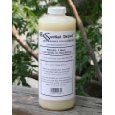 There are a huge variety of soap making oils, fats and butters that can be used in Soap Recipes for making bars of natural lye soap. Each oil has specific qualities and adds certain characteristics to you soap.
There are a huge variety of soap making oils, fats and butters that can be used in Soap Recipes for making bars of natural lye soap. Each oil has specific qualities and adds certain characteristics to you soap.
Soap making Oils and their Characteristics
Terms:
Saturated Fats – Oils that make a hard soap. Usually come in a solid form and need to be heated to a melt before using. Coconut, cocoa butter, Palm oil are examples.
Scenting Oils – There are two main types of scenting oils. Fragrance oils are man-made and contain alcohol. Essential oils are naturally occurring oils. The alcohol in fragrance oils can cause problems in soap making so essential oil’s are normally used in soap making. Essential Oil’s are more expensive and harder to find than Fragrance Oil’s but have better scent retention and will not ruin a batch of soap. The only time fragrance oils can be used safely is at the trace stage or during rebatching. Essential oils can be added at trace or in the base oil.
Superfatting Soap – This means that oils or fats have been left in the soap unconverted by the lye. This can occur in one of two ways. The amount of lye can be decreased to allow some fat/oil to remain in the finished soap. The second method is for oil or fat to be added at the trace stage after the mix had saponified. (In lay terms saponification means that the lye/water and oils have been mixed and brought to a trace stage where at this point the lye has been mostly neutralized. Any oil added at this stage will basically remain unchanged in the final soap bar) The method of adding additional fat to the soap mixture after it has saponified had a definite advantage in that it allows the soap maker to better control what oil is left in the soap. Adding the extra oil at this time keeps it in its natural state, and ready to instantly moisturize your skin as you use the soap. When using the super fat method at the trace stage make sure you use 1% as your excess fat lye amount. Otherwise the soap will be too oily because it will not only contain the oil you add at the trace stage but will also have excess fat from a lack of lye. You basically want all the original oils to become soap and the oils you add at trace to be left in the soap as moisturizers.
Superfatting soap by decreasing the lye content eliminates the step of adding oil at trace but decreases the control that the soap maker has over what oil is left in the soap. Here is an example. If 5% cocoa butter was added as part of the base oil (say 95% Olive Oil) and the lye amount was calculated for a 5% excess fat level the excess fat in the soap would be made up of a combination of Olive oil and cocoa butter with most of the excess fat being Olive oil. (5% of the cocoa butter would be left and 5% of the olive oil.) If the same batch was mixed using just Olive Oil at a 1% excess fat level and the cocoa butter was added at the trace stage you would know that the final soap bar contained 1% olive oil and 5% cocoa butter. The reason for this is that the cocoa butter would have in this case been unaffected by the lye since it was added after the soap had traced.
(NOTE – When adding oils at the trace stage (superfatting) be sure to use a lye calculatation that gives you about 1% excess fat. Otherwise your soap will be too oily. When using our Soap-Calc program or any other lye calculator do not include the oils that you will be adding at trace in the calculation)
Trace – The point at which the soap mixture starts to thicken. If you take a spoonful of the mixture and pour it over the soap it leaves a trace. Hence the name trace. At this point the solution is about 80-90% saponified and essential oils, superfatting oils, colors, additives, etc can be added without their characteristics being substantially altered by the saponification process.
Unsaturated Fat Oils – Oils that are in a liquid form. Alone they will create a soft spongy bar. They need to be mixed with saturated fats at the base oil stage in order to create a hard bar.
Soap making Oils:
Some of the oils below are for use at the trace stage so that they will remain in the soap. Others are added into the base to add certain characteristics such as lather or hardness. Most of the oil names below are “clickable” and will show you the price for the oil in different quantities and where to buy it.
Sweet Almond Oil
![]() Sweet Almond Oil is often used for superfatting soaps. It is a great moisturizer, makes a stable lather and helps condition the skin. It is recommended that you add 1 ounce per pound of fats to your soap batch at trace.
Sweet Almond Oil is often used for superfatting soaps. It is a great moisturizer, makes a stable lather and helps condition the skin. It is recommended that you add 1 ounce per pound of fats to your soap batch at trace.
Aloe Vera Liquid, Aloe Vera Gel
Aloe vera is used in creams and lotions. It is well known for being a healing and soothing agent for damaged, dry skin. It is also soothing and healing for burns, skin irritations, and raw open wounds. Liquid aloe vera may be added to cosmetic formulations, soaps, and straight on the skin. When adding to soap do it at the trace stage. You want as much to make it into the soap as possible.
Apricot Kernel Oil
Apricot kernel oil is often used for superfatting. It is also a good moisturizer and helps condition the skin. It is recommended that you add one or two ounces in every pound of fat at trace.
Avocado Oil
Avocado oil is a great moisturizer and is often used for superfatting soaps. Avocado oil contains vitamins A, D, and E, which makes it healing as well as moisturizing. Try it in a gentle baby soap. It is recommended that you add up to 30% as base oil.
Beeswax
 Beeswax has the sweet smell of honey. Beeswax makes a harder bar of soap and is also used in creams, lotions, lip balms and candle making. It contains a high percentage of unsaponifiables. At best, half of these substances participate in the normal soap making reaction. It is recommended that you add about 1 oz per lb. of oils in your base oils to make your soaps harder.
Beeswax has the sweet smell of honey. Beeswax makes a harder bar of soap and is also used in creams, lotions, lip balms and candle making. It contains a high percentage of unsaponifiables. At best, half of these substances participate in the normal soap making reaction. It is recommended that you add about 1 oz per lb. of oils in your base oils to make your soaps harder.
Calendula Oil
Has many therapeutic benefits and is known to successfully heal a variety of types of skin damage. (burns,wounds,dry skin) To superfat soap use 1 2/3 tablespoons per 5 lbs of soap at trace or use up to 20% added to other oils at the beginning of the soap making process.
Canola Oil
Canola oil is a good moisturizer but is less saturated than other fats, so it can be slow to saponify. Use it in place of more expensive oils like olive. Needs to be mixed with other saturated fats in order to speed up saponification. Use as a base oil up to 50%.
Castor Oil
Castor oil is often used to superfat. It attracts and holds moisture in the skin. You can use it in your base oils to produce a nice hard bar of soap. You can also add a 1-2% at trace for superfatting. Add it to your base oils at a rate of no more than 30% in the beginning of the soapmaking process.
Cocoa Butter
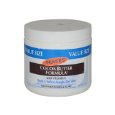 Cocoa butter is a wonderful product and is used in the base oils to make soaps harder. When used at trace as a superfatting oil it acts to lay down a protective layer which holds the moisture to the skin, so it is an excellent skin moisturizer/softener. It has a natural chocolate scent but it is also available in unscented versions. You can use it from anywhere about 1 ounce to a pound at trace, to 15% of your total base oils, depending on your preference.
Cocoa butter is a wonderful product and is used in the base oils to make soaps harder. When used at trace as a superfatting oil it acts to lay down a protective layer which holds the moisture to the skin, so it is an excellent skin moisturizer/softener. It has a natural chocolate scent but it is also available in unscented versions. You can use it from anywhere about 1 ounce to a pound at trace, to 15% of your total base oils, depending on your preference.
Coconut Oil
 Coconut oil makes soaps lather beautifully and is a very popular oil for soaps. It can be drying when it makes up too large portion of your soap’s base oils so make sure your recipe contains enough for lather and hardness but not too much. It will make a very hard, white bar of soap with abundant lather. It even lathers in very hard water or even sea water). Coconut oil is a saturated fat meaning it must be melted before lye is added. Use it at a percentage of no more than 20-30% in your base oils.
Coconut oil makes soaps lather beautifully and is a very popular oil for soaps. It can be drying when it makes up too large portion of your soap’s base oils so make sure your recipe contains enough for lather and hardness but not too much. It will make a very hard, white bar of soap with abundant lather. It even lathers in very hard water or even sea water). Coconut oil is a saturated fat meaning it must be melted before lye is added. Use it at a percentage of no more than 20-30% in your base oils.
Cottonseed Oil
Cottonseed oil produces thick and lasting lather, in addition to having emollient properties. It can be vulnerable to spoilage depending on the season, so keep this in mind when making batches with this oil. The Maximum recommended usage is 25% of total base oils.
Emu Oil
![]() Emu Oil is reported to help heal skin tissues and help draw other ingredients (like mint) down into your skin so they are more effective. The recommended usage of this oil is 1 ounce per pound at trace.
Emu Oil is reported to help heal skin tissues and help draw other ingredients (like mint) down into your skin so they are more effective. The recommended usage of this oil is 1 ounce per pound at trace.
Evening Primrose Oil
Evening primrose oil is absorbed quickly into skin and provides essential fatty acids that are said to help inhibit bacterial growth and encourage antibodies so the skin is better able to defend against infection or inflammation. It is not recommended as an additive in soaps made for oily complexions. It is recommended that you add 2 tablespoons per 5 pounds of soap, added at trace.
Grapeseed Oil
Grapeseed oil is a lightweight oil that absorbs into the skin quickly without leaving a heavy greasy feeling. Used in soaps as a superfatting oil. It is recommended that you add one ounce per pound at trace.
Hazelnut Oil
Hazelnut is an excellent moisturizer for soaps. It is low in saturated fatty acids, so use other more saturated fats to lessen your trace time and yield a harder bar. It is recommended that you make this part of your base at a rate of 20% of total oils.
Hempseed Oil
Hempseed oil is not as stable as some other oils and can spoil quickly. It creates a silky bar of soap even if it is only used as a superfatting oil. It is a less saturated fat, and since it is prone to spoilage, keep it as a small percentage of your mix to avoid having a soft, squishy soap that may spoil in a few months. Usage – As a Superfatting at 5% at trace or Base oil at 20-30% but no more than 40%.
Honey – (this is not an oil but it can be used as an additive)
Honey is also a humectant, meaning that it helps retain moisture on the skin much like glycerin does. It is recommended that you add 2 Tablespoons per pound of oils, added at trace.
Jojoba Oil
Jojoba helps to promote a stable lather and is good at conditioning skin. Because of its expense, it’s usually used to superfat soap batches or in shampoo bars. It is an excellent emollient for skin conditions like psoriasis, because it has a chemical composition very close to the skin’s own sebum. It is suitable for all skin types, beneficial for spotty and acne conditions, and great for sensitive or oily skin. It is reported to help to unclog the pores and remove any embedded grime. It also restores and conditions hair. When using Jojoba in soap, limit its usage to one or two ounces per pound at trace. Jojoba Oil naturally accelerates tracing in soap recipes. Used as a Superfatting oil.
Kukui Nut Oil
The kukui nut is native to Hawaii and is high in linoleic acid. It is quickly absorbed into the skin. Excellent for skin conditioning after excess sun exposure, as well as for the treatment of acne, eczema, and psoriasis. It offers just the right amount of lubrication without leaving you with a heavy greasy feeling. For soap making, use 2 tablespoons added to 5 lbs of soap at trace just before incorporating the essential oils to add richness to the soap. A higher percentage, 10-20% of the total fats in the base also makes an outstanding soap.
Lard
Lard is made from pig fat much like bacon fat. Its advantages are that it is cheap, easily obtainable, and makes a nice lathery, white bar of soap. This fat should be combined with vegetable oils such as coconut or palm oil to offset lard’s shortcomings. If you don’t use other oils the soap can tend to be soft and not work very well in cold water. Use Lard as a base oil. It is recommended to use 70% max of total oils.
Macadamia Oil
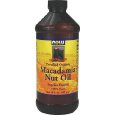 Macadamia is a luxurious and slightly expensive oil. It has a long shelf life so it can be purchased in quantity for a good price. It is a great addition to any soap formula. It is easily absorbed into the skin and acts as an emollient protecting skin cells from deterioration and thus leading to better condition for your skin. Use for superfatting your soap. It is recommended that you add 1 ounce per pound at trace.
Macadamia is a luxurious and slightly expensive oil. It has a long shelf life so it can be purchased in quantity for a good price. It is a great addition to any soap formula. It is easily absorbed into the skin and acts as an emollient protecting skin cells from deterioration and thus leading to better condition for your skin. Use for superfatting your soap. It is recommended that you add 1 ounce per pound at trace.
Mango Butter
Mango butter is a butter that is extracted from the mango fruit. It is a yellowish oil and has almost no scent. It is a great moisturizer and is recommended to be used to superfat batches. It is recommended that you add 15% of base or as a superfatting agent at 5% at trace.
Monoi Oil, also known as Monoi de Tahiti
Monoi oil is expensive but luxurious product made from coconut oil. It oil has wonderful moisturizing properties and is great for your skin. Use it as a base oil at 60% or higher.
Neem Oil
Extracted from the bark of the Neem Tree. This oil has the unique ability to treat a variety of skin disorders such as dandruff. It is recommended that you use it as a base oil up to 40%.
Olive Oil
 This is one of the more popular oils. Olive oil is excellent as a base oil. It is often combined with a little coconut or palm oil to give the bar lather and hardness. Avoid extra virgin olive oil. It is great for cooking but not for soap making. For soap, the lower the grade the better. Olive Oil prevents the loss of your skin’s natural moisture, softens skin and attracts external moisture to your skin. It helps keeps your skin soft, supple and younger looking. If you’re making an especially mild soap such as baby or no more tears soap use Olive oil. Use as a base oil up to 100% but normally around 80%.
This is one of the more popular oils. Olive oil is excellent as a base oil. It is often combined with a little coconut or palm oil to give the bar lather and hardness. Avoid extra virgin olive oil. It is great for cooking but not for soap making. For soap, the lower the grade the better. Olive Oil prevents the loss of your skin’s natural moisture, softens skin and attracts external moisture to your skin. It helps keeps your skin soft, supple and younger looking. If you’re making an especially mild soap such as baby or no more tears soap use Olive oil. Use as a base oil up to 100% but normally around 80%.
Palm Oil, also known as Vegetable Tallow
Palm oil makes a hard bar that cleans well and is also mild. It is a great substitute for tallow in all-vegetable soap formulas. The quality of Palm oil is going to be far superior to other vegetable oils that are filler oils. Palm oil is a universally popular soap oil and used in many expensive luxury soaps. Use is as a Base oil at 20 – 30%.
Palm Kernel Oil
Like Palm Oil, Palm Kernel oil makes a soap that is very hard and lathers well. It has most of the same qualities as palm oil. It is recommended that you use palm kernal oil as a Base oil at 20-30%
Peanut Oil
Peanut oil can be used in soap recipes to create a long-lasting lather. It is highly unsaturated though, so it is prone to spoilage. Because of this avoid using more than 20%. Peanut oil is similar to olive and castor oils and has a good amount of vitamin E. Do not use this if you are allergic to peanuts. It is recommended to use this oil as a base oil up to a 20% maximum.
Safflower Oil
Safflower oil is an unsaturated oil and should be used in combination with palm, coconut, or a similar oil to add hardness and lather to the bar. It is valuable for its moisturizing properties. Recommended to use it as Base oil up to 60%. 20% of total is popular ratio.
Sesame Seed Oil
Sesame oil is said to be good for Psoriasis, Eczema, Rheumatism, and Arthritis. It makes a good superfatting oil due to its moisturizing ability. It has a strong nutty scent. It makes a soft spongy bar unless used in conjunction with other oils such as palm or coconut. Use it as a 10% addition to base oils for best results.
Shea Butter
Shea butter is a wonderful superfatting agent and contains a large percentage of ingredients that do not react with the lye and will thus remain in the soap to nourish your skin. You can add it to your base at up to 20% of your total oils or use it as a superfatting agent at 1 – 2 tablespoons per 5 pounds of oils added at the trace stage.
Vegetable Shortening or Soybean Oil
Vegetable shortening is normally made out of soybean oil. It is cheap and readily available and produces a mild, stable lather. Use it in combination with other exotic or moisturizing oils. Use this as half of your fats to keep costs down. It is a good cheap filler oil and makes a very hard white bar when used alone or mixed with other oils. You should use vegetable shortening as a base oil or combine it with other, saturated oils for better results. Recommend use as base up to 50% of total oils.
Sunflower Oil
Sunflower oil is a less expensive alternative to olive oil. It contains Vitamin E, so it naturally resists spoiling since vitamin E is a natural preservative. Even so, don’t store it longer than six months. It is a less saturated oil so you want to combine it with other, more saturated oils such as coconut or palm oil. You should try to avoid using more than about 15-20% sunflower oil in your formula. It can make your soaps take longer to trace and to harden. It is recommended that you use it as a Base oil up to 20%
Wheat Germ Oil
This oil is a thick, sticky oil and also an antioxidant. It’s also very rich in vitamin E so it is not prone to spoiling. Wheat germ oil can be used to nourish dry or cracked skin and soothes skin problems such as eczema and psoriasis. It is also reported to help prevent and reduce scarring and may prevent stretch marks. Mature skin can especially benefit from wheat germ oil. Some people use it as a preservative in vegetable oils, soaps and toiletries. On its own, wheat germ oil oxidizes rapidly so it should be kept refrigerated. It is recommended that you add 1 ounce per pound added at trace.
How to Make Soap in a Blender
Making soap in a blender is fun and easy. It is quicker than standard cold process or hot process soapmaking and has some advantages as well as one limitation.
Before you begin you will need to decide on a soap recipe. Check our free soap recipes listed to the right. I would suggest using a formula that includes some Palm oil and/or Coconut oil. These two oils are essential if you want a hard bar of soap that lathers well. They also create a fairly quick trace time. It is recommended that you run whatever recipe you select through a lye calculator like our Soap-Calc or one of the free online SAP calculators. By doing this you can be sure that you will be using the proper amount of lye. Also, you can adjust the lye content to leave excess fat in your soap. A bar with more excess fat (over 5%) will moisturize your skin better. Bars with less than 5% excess fat will leave you feeling cleaner. A lot of this depends on your skin type. It is nice to be able to alter this characteristic with just a slight lye adjustment.
Making Soap in a Blender
The only limitation in making soap in a blender is that it does not allow for big batches of soap. 16 ounces is about the limit. However, it has four nice advantages:
1) Blending your soap mix creates a much shorter trace time. Instead of 15 – 40 minutes, it might require only minutes or even seconds depending on what type of oils you use. This means you can mix and pour a batch in much less time. It also eliminates all the stirring that must be done with cold process methods.
2) Since liquid fat and oils can be used at room temperature, there is no need for a thermometer. If you have some solid fats like lard simply heat them until they are melted and add to the blender. This means that in many cases you do not need to use a stove to heat the oils.
3) The blending process effectively whips the lye and water into the oil and fats producing a much smoother mixture. This lowers the chances of your mix separating. This lowers the number of bad batches.
4. Your soap bars will be creamier in consistency and will even float due to the air that is whipped into the solution. The final product is smoother and higher in quality.
(Use small one-pound batches only).
Step One – Dissolve the lye in cold water and wait until the solution cools and the mixture turns clear. At this point the lye is ready to begin converting oil to soap. It is also very caustic so make sure you are wearing goggles and gloves when handling lye. Never pour water into lye. Only pour lye INTO water.

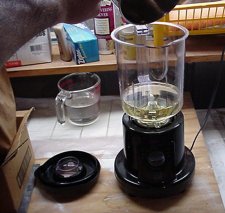
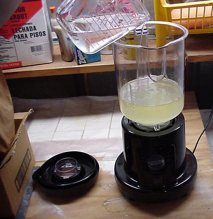
Step Two – Carefully pour the oil into the blender. Then carefully pour the lye/water solution into the blender. The blender will of course be OFF when you are doing this. Be careful not to splash or spill the lye solution on yourself or others. Make sure you are wearing goggles and gloves.

Step Three – Lock the blender in position, secure the cover and place a towel over the top of the blender for safety. Begin blending at the lowest possible speed. Again, make sure to wear goggles when you process the soap mixture and make sure the towel is in place to avoid any accidental splashing of the lye/oil mixture. If you do this there will be almost no chance of any accidents.
Stop the blender and check the soap often to watch for what is called a thin-trace stage. This is point at which the soap mixture begins to thicken. If you were to take a spoonful and drizzle it over the mixture it would make a trace on the surface. Each time you stop the blender, wait a few seconds before removing the cover. When you remove the cover keep the towel between you and the blender just in case some soap splashes. Sometimes the soap “burps” when it stops as trapped air comes to the top. At the thin trace stage, stop the blender and stir the soap to check for tracing and to allow bubbles to escape. At this point you are trying to avoid letting the soap get too thick. If it hardens in the blender that can cause issues.
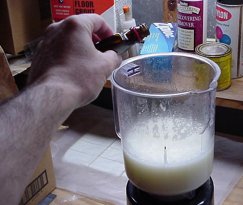
Step Four – At this point you can add any essential oils,colorants or fragrances as well as any other ingredients such as oatmeal or herbs. You add them at this point because the lye has done most of its work and will not affect the extra ingredients as much. Blend these in for a few seconds and then stop the blender.

Step Five – Carefully pour the soap into individual molds or one mold. Cover it with a blanket for insulation. Larger molds work well because the soap stays together and keeps itself warm. Cooling too fast can alter the curing process and ruin a batch. A warm, dry room is best. Let the soap set for a day or two and then after popping it out of the molds cut it and let it age for at least three weeks.
At this point your soap should be ready to use. You can check the ph level with a test strip if you wish. Between 8.5 and 10 is the goal.
Buying or Making your Soap Molds
More about MOLDS : You can use almost anything glass, stainless steel or plastic as a soap mold. You can use a wooden box lined with saran wrap, a pvc pipe capped on one end or candy molds. A PVC pipe makes a neat mold. All you do is spray the inside with PAM and then pour the soap solution into the pipe,let it set, and then uncap and push the soap out of the mold. You then can cut it into round pieces. Wooden molds lined with wax paper work well also. Wood soap molds can be taken apart easily to remove the soap. Then the soap is sliced and aged.
The Chemistry Behind Soapmaking / How is soap made?
Soap is a byproduct of a chemical reaction that takes place between oils or fats and sodium hydroxide or lye. When mixed with water and then with oils or fats a process called saponification takes place. The initial saponification process takes anywhere from 20 – 90 minutes. After the soap mixture is poured into a mold the rest of the saponification takes place and can take from 5 – 6 weeks. Once the soap has cured it can be tested for proper ph levels using a test strip. You are looking for a ph level of 8 – 10.5.
Each oil has a different SAP value which determines the amount of lye it will take to convert that oil into soap. If you mix oils you will need to calculate a blended SAP value. Programs like our Soap-Calc spreadsheet can help you do this.
Basic Ingredients That You Will Need for Soapmaking
Ingredients that you will Need to Make Soap
Oil and/or Fats – Almost any natural oil or animal fat can converted into soap using lye. Each has its own special characteristics and creates different properties in the soap that it becomes. Some popular oils are coconut oil, canola oil, olive oil, vegetable shortening, palm oil, bacon grease, and lard. Note – We have more information about the different type of oils and their properties at the following link.
100% Lye (NaOH) Sodium Hydroxide – Lye is the chemical that converts oil or fats to soap. Before it was readily available it was extracted from ashes left over from a fire. Red Devil lye is a popular brand. We have a link below with sources of lye if you have problems finding it locally.
Water – Distilled water or bottled water is preferable. The minerals in hard tap water are not needed for soapmaking and can cause problems. Pure distilled water is all you need.
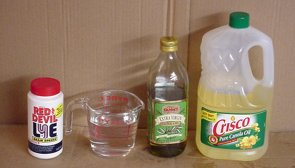
Essential Oils and Fragrances- These can be added but are not required. They add a nice fragrance to your soap which most people prefer. Stay away from any scents that contain alcohol since it can adversely affect a formula and cause unwanted results. Also, avoid potpourri, candle scent oils and commercial perfumes. These ingredients are not made for soap and can cause problems. Essential oils and fragrance oils are fine to use and are commonly available at health food stores. They are generally used for aroma therapy.
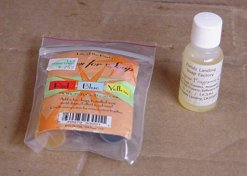
Other additives – Oatmeal, spices, ground up pumice, sage, ground apricots, herbs and other ingredients can also be added to soap at the trace stage to add texture, fragrance or function.
Soap Colorants – These can be purchase from a soap supply store or you can use crayons that are made using stearic acid (common) If you use crayons melt a piece first and add it to the soap mix at the trace stage. It is best to use commercially available colors. In other words, use colors that are designed to be used in soap.
Equipment and Tools that you will need
First, let me say that you can get almost everything you need to make soap at Walmart or a Grocery Store. You can also buy soapmaking supplies online. This goes for equipment and tools also. Here are the basic supplies that you will need.
-A Pair of safety goggles and a long sleeve shirt or coveralls. (Important)
-A Pair of rubber gloves or dish washing gloves to protect your hands from lye. (Important)
-Two 1/2 gallon Rubbermaid type pitchers that are dishwasher safe. One will be used for water and the other for lye.
-Some durable plastic stirring spoons. One will be for oils and one will be for lye/water mix.
-Glass candy thermometers for check the temperature of your oil and soap mix. (do not use aluminum)
-Large enameled or stainless pot to melt oils in. A 16 quart pot should work fine. Avoid using aluminum pots.
-Old blankets for insulating the soap when it is in the molds.
-Kitchen food scale or postal type scale.
-Saran type food wrap to be used to line molds)
-A collection of molds. Different shapes and types.
-Stick Blender is optional (creates a faster trace)

For making blender soap you will also need:
-Standard Kitchen type Blender with a lid
-Towel to cover the blender when it is in operation.


Safely Working with Lye (Sodium Hydroxide)
Safely working with lye
If you are going to make soap at home you are going to have to deal with lye. Lye is also known as sodium hydroxide and is the key ingredient in soap. It is the chemical that converts the oils and fats. Lye is one of the key ingredients in drain openers such as “Drano” or “Liquid Plumber” because of its amazing ability to convert greasy buildup into a soluble substance and clearing a clogged line. Lye should be handled in the same way that drain cleaner, bleach, gasoline or pool chemicals would be handled. If mishandled it can be a dangerous chemical and can cause harm to you and others. If handled correctly these kinds of problems can be avoided. There is no reason why accidents involving lye cannot be completely avoided. As with all dangerous chemicals, keep them away from children.
You can substantially reduce your chances of ever having an accident with lye by remembering four simple things.
1. Never pour water into lye. Always pour lye into the water. (slowly) If you pour water onto lye it can cause a violent reaction.
2. Secondly, be careful not to splash or spill the lye solution. Pre-plan every move you make. Don’t use containers that spill easily. Use stable ones. Stir slowly. Keep other people away while you are working.
3. When handling lye wear goggles, rubber gloves and long sleeves. This will protect you in the event some lye splashes onto you.
4. Keep water near by to wash off any lye that may get on you.
5. Keep lye out of the reach of children.
Please read the following safety information regarding lye.
Warning: Keep children and animals away from lye (sodium hydroxide). Lye is very caustic and can cause serious injury or even death if swallowed and can cause blindness if splashed into the eyes. Always wear long sleeves and be sure to always wear safety goggles. Always keep a large cup of fresh water nearby. If you should splash some lye or raw soap into your eye, IMMEDIATELY pour large amounts of cool water into your eye continuously for 10 minutes, or longer. Visit your nearest hospital emergency room or call 911. If you should splash lye or raw soap onto your skin, rinse immediately with cool water. For more serious skin burns, seek medical care immediately. If lye is accidentally swallowed, do not induce vomiting, call your poison control center or 911 for further instructions, get to emergency fast. It is important to have your lye containers labeled. Again, keep lye away from children and when working with lye keep children away from your work area.
